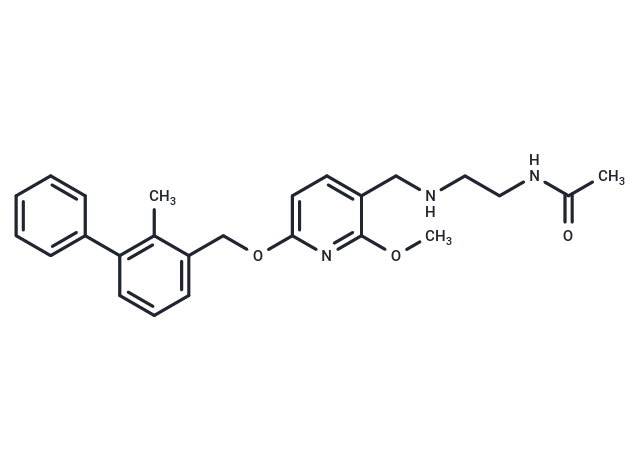Shopping Cart
Remove All Your shopping cart is currently empty
Your shopping cart is currently empty
BMS-202 (PD1-PDL1 inhibitor 2) is an inhibitor of the PD-1 (Programmed death- 1) /PD-Ll (Programmed death-ligand 1) protein/protein interaction.

| Pack Size | Price | USA Warehouse | Global Warehouse | Quantity |
|---|---|---|---|---|
| 1 mg | $41 | In Stock | In Stock | |
| 5 mg | $102 | In Stock | In Stock | |
| 10 mg | $163 | In Stock | In Stock | |
| 25 mg | $323 | In Stock | In Stock | |
| 50 mg | $538 | In Stock | In Stock | |
| 100 mg | $633 | In Stock | In Stock | |
| 1 mL x 10 mM (in DMSO) | $108 | In Stock | In Stock |
| Description | BMS-202 (PD1-PDL1 inhibitor 2) is an inhibitor of the PD-1 (Programmed death- 1) /PD-Ll (Programmed death-ligand 1) protein/protein interaction. |
| Targets&IC50 | PD-1/PD-L1:0.018 μM |
| In vitro | BMS-202 inhibits PD-1/PD-Ll interaction, and may augment therapeutic immune response to a number of histologically distinct tumors. Blockade of the PD-1/PD-Ll ligation using antibodies to PD-Ll has been shown to restore and augment T cell activation in many systems[1]. |
| Kinase Assay | All binding studies are performed in an HTRF assay buffer consisting of dPBS supplemented with 0.1% (with v) bovine serum albumin and 0.05% (v/v) Tween-20. For the PD-l-Ig/PD-Ll-His binding assay, inhibitors are pre-incubated with PD-Ll-His (10 nM final) for 15 m in 4 μL of assay buffer, followed by addition of PD-l-Ig (20 nM final) in 1 μL of assay buffer and further incubation for 15 m. PD-L1 from either human, cyno, or mouse are used. HTRF detection is achieved using europium crypate-labeled anti- Ig (1 nM final) and allophycocyanin (APC) labeled anti-His (20 nM final). Antibodies are diluted in HTRF detection buffer and 5 μL is dispensed on top of binding reaction. The reaction mixture is allowed to equilibrate for 30 minutes and signal (665 nm/620 nm ratio) is obtained using an En Vision fluorometer. Additional binding assays are established between PD-1-Ig/PD-L2-His (20, 5 nM, respectively), CD80-His/PD-Ll-Ig (100, 10 nM, respectively) and CD80-His/CTLA4-Ig (10, 5 nM, respectively). |
| Synonyms | PD1-PDL1 inhibitor 2, PD-1/PD-L1 inhibitor 2 |
| Molecular Weight | 419.52 |
| Formula | C25H29N3O3 |
| Cas No. | 1675203-84-5 |
| Smiles | COc1nc(OCc2cccc(c2C)-c2ccccc2)ccc1CNCCNC(C)=O |
| Relative Density. | 1.133 g/cm3 (Predicted) |
| Color | Yellow |
| Appearance | Solid |
| Storage | store at low temperature | Powder: -20°C for 3 years | In solvent: -80°C for 1 year | Shipping with blue ice/Shipping at ambient temperature. | |||||||||||||||||||||||||||||||||||
| Solubility Information | DMSO: 45 mg/mL (107.27 mM), Sonication is recommended. Ethanol: 83 mg/mL (197.85 mM), Sonication is recommended. | |||||||||||||||||||||||||||||||||||
| In Vivo Formulation | 10% DMSO+40% PEG300+5% Tween 80+45% Saline: 4.5 mg/mL (10.73 mM), Solution. Please add the solvents sequentially, clarifying the solution as much as possible before adding the next one. Dissolve by heating and/or sonication if necessary. Working solution is recommended to be prepared and used immediately. The formulation provided above is for reference purposes only. In vivo formulations may vary and should be modified based on specific experimental conditions. | |||||||||||||||||||||||||||||||||||
Solution Preparation Table | ||||||||||||||||||||||||||||||||||||
DMSO/Ethanol
| ||||||||||||||||||||||||||||||||||||
| Size | Quantity | Unit Price | Amount | Operation |
|---|

Copyright © 2015-2026 TargetMol Chemicals Inc. All Rights Reserved.